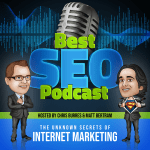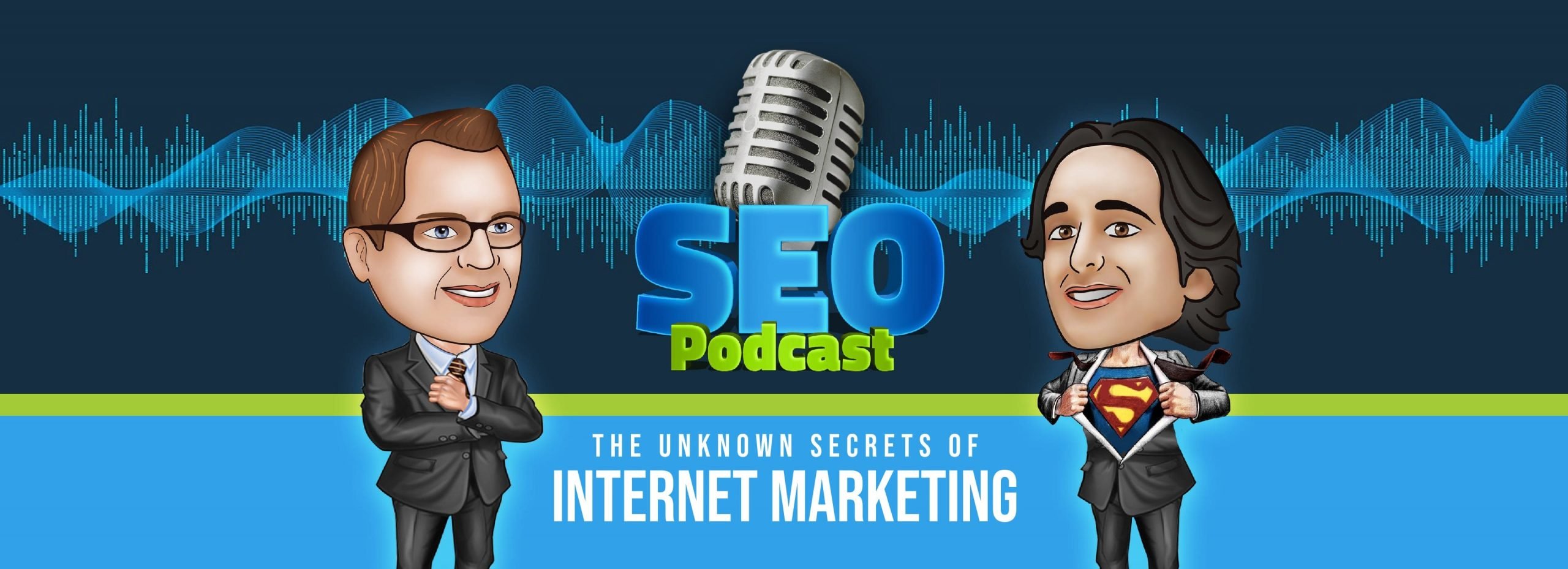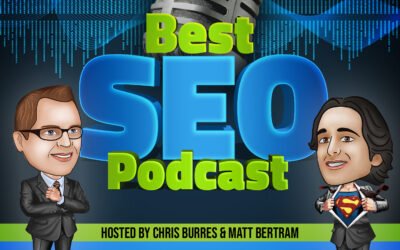

Video Transcript
Chris: Hi and welcome to the SEO Podcast: Unknown Secrets of Internet Marketing. My name is Chris Burres, owner of eWebResults.
Matt: My name is Matt Bertram, your Shopify Samurai.
Chris: Welcome back to another fun-filled– Shopify Samurai?
Matt: Yeah.
Chris: I like that. Welcome back to another fun-filled edition of our podcast. This is Podcast #417. As you YouTubers can see behind us: #417. As always we do have a tip from the previous podcast, and that tip is–
Matt: And our tip is extremely long.
Chris: It’s really long, we’ve been doing some recording already.
Matt: And it’s about anchor text, right?
Chris: Yes.
Matt: And so we talked about last time you gotta break apart your anchor text into like four quarters, right? So you wanna have naked keyword text, you wanna have your company name, you wanna have long-tail phrases, and target phrases, and have a nice mix.
Chris: Yeah, a good mix. Make sure that you don’t set off any Google alarms. Subscribe. Follow.
Matt: Boom!
Chris: Alright, so–
Matt: Good job.
Chris: Alright, so please remember we were filmed live here in Houston, Texas, and Matt and I we are your–
Chris & Matt: Results Rebels!
Chris: I like that, Results Rebels. That feel really good. Hey, I wanted to jump into this review for two reasons. One: because we have a review it means I did not get a tear tattoo on my eye.
Matt: That’s good.
Chris: That’s always a good thing.
Matt: Yeah.
Chris: And this review, you’re gonna appreciate this.
Matt: Oh, okay.
Chris: I feel like you maybe paid somebody to write this review. That’s what I’m just thinking.
Matt: Oh, really? Okay.
Chris: It’s from SK and it is of course–
Chris & Matt: 5 stars!
Chris: It says, “Wow, just wow. Thank you!!!” Three exclamation marks.
Matt: Wow, okay.
Chris: “Matt answered what I thought was gonna be a typical sales call. He took the time to look at my website, be supportive and give me practical tips based on my budget. I’m a small business, medical in Canada, and he was super helpful.”
Matt: Wow. I would just say like, that’s what happens when I sometimes pick up the phone, you know? You never know, I might answer the phone when you call.
Chris: He doesn’t always answer the phone, but when he does you get a really cool experience. Yeah, punch in the face to SK for taking the time to write that review.
Matt: Thank you.
Chris: Punch in the face for you.
Matt: Oh, thank you.
Chris: For delivering so much value to SK, that’s pretty awesome. If you’ve been here before, you may be back and may like the tips and tricks that we give you, you might be interested in, “5 Online Marketing Mistakes That Can Tank Your Business & How to Avoid Them.” You can find those by going to eWebResults.com/
Chris & Matt: SEOTips
Matt: And we need to add SEOTip, because a lot of people are typing SEOTip and it’s not coming up. So we need to get that done and get that redirected. Adam: [00:02:27] [Oh, so you use the hashtag #SEOTip for that redirect?]
Matt: Yes, and we need to get some more lead magnets for all you out there that already download.
Chris: Okay, alright. We do have a teaser. This article is from Jen Rubio, “6 E-Commerce PPC Best Practices to Improve Your Advertising ROL.” Jen–
Matt: ROL?
Chris: ROL, yeah.
Matt: What’s ROL?
Chris: Rolling On Floor?
Matt: Whoo! I like it.
Chris: ROI. She’s with Vertical Measures. If you’re in a position right now and you can tweet, hashtag or do all that fun stuff, what we’d like to do is #SEOPodcast, this is Podcast #417. Tag us @BestSEOPodcast, @eWebResults– Oh, there’s a new one. @MattBertramLive.
Matt: Yes.
Chris: Add that to it, and also add @VerticalMeasure. Let them know that we’re talking about their article.
Matt: Yup.
Chris: And again it’s, “6 E-Commerce PPC Best Practices to Improve Your Advertising–” not ROL, ROI. So I’m pretty excited about jumping into that. If this is the first time you’ve listened to the podcast–
Chris & Matt: howdy!
Chris: And welcome to the show. We’re from Texas so we do say howdy, that’s how that rolls.
Matt: And if you went to A&M too, howdy.
Chris: Also howdy, right? And if you’ve listened to the podcast before, you know the section that we’re not gonna skip.
Matt: Whoo!
Chris: Yeah. So we run a contest each and every week, it’s a simple contest. If we get 1 review and 10 shikos–
Matt: A share, a like, and a follow.
Chris: If we get 10 shikos and 1 review, we move this piece to the end. We got the review, also I didn’t get the tear tattoo that comes with not getting a review.
Matt: Ah.
Chris: And we did not get the 10 shikos. We got close, we did not get close enough. So what we would like you to do is leave a review for us, and you can leave that review at eWebResults.com/
Matt: SEOTrust. No, eWebResults/Trust.
Chris: Trust, and that’s gonna take you to our profile at Trust Pilot, so please leave us a review and hopefully you can make that review–
Matt: 5 stars!
Chris: Next. Here’s all the ways that you can shiko us. You can go to Facebook.com/
Matt: eWebResults
Chris: Twitter.com/
Matt: eWebResults
Chris: Instagram.com/
Matt: eWebResults
Chris: If you wanna get to YouTube, you gotta go to eWebResults.com/
Matt: YouTube, tricky.
Chris: And finally LinkedIn.com/company/
Matt: You guess it, eWebResults.
Chris: All of those will take you to our profiles on those platforms. Please shiko us while you are there.
Matt: Lets get a conversation going.
Chris: Yeah. If you’d like a free website analysis, we can do that for you.
Matt: We can.
Chris: You just heard the review from SK, that was the process of a free website analysis. You can get that free website analysis by going to eWebResults.com and clicking the really– well just click the button.
Matt: Free Website Analysis, yeah.
Chris: That says Free Website Analysis. I think that’s fairly self-explanatory.
Matt: Above the fold.
Chris: Alright, so we got couple questions here that people have sent in. So this is pretty exciting. One is from Charlie Godfrey.
Matt: Okay.
Chris: That is– he sent it to me or us on LinkedIn. Me on LinkedIn. And it says, “I listen to your podcast and find it really helpful with staying up to date with SEO and PPC news. I just listened to one of your podcasts about Geofencing and wonder your thoughts on how the new GDPR laws may affect geofencing in the future.” So the GDPR are privacy laws that really affect the EU, so we don’t think about it.
Matt: Yeah, we don’t worry about it. We’re in the US.
Chris: So I did pull up an article. I think geofencing is probably not a concern, but you definitely wanna dig in and understand that from somebody who has more understanding of those particular laws. So if you’re over in the EU, it’s probably very normal for you to see, “Hey, this website uses cookies,” right? Here in the US we’re not required to do, “Hey, this website requires cookies.”
Matt: Yeah.
Chris: Which I’m assuming that most of the sites, if you visit them frequently, have actually done some IP targeting and actually have added that piece if you’re over in Europe.
Matt: I’ve seen little notifications pop-up about it now and then.
Chris: Now and then, yeah. And when we see it, it’s usually an indication that they do a lot business over in Europe, and so they’ve gotta have these to conform to those laws. We don’t have to do some of that, so just make sure you dig in there. Punch in the face Charlie, we’re now connected on LinkedIn. And then this is a question for you Matt, ‘cause you were coming up with random numbers and statistics in the last podcast. So, [00:07:01] [John Huey] he says, “Hi guys, in your podcast for anchor text, you give advice on internal and outbound links.” That was about 20 minutes in that he says, “Do you mean across the whole site or per page? Great show by the way, really relevant stuff. So thank you.” So you’re name is not John, that’s his name. John is asking when you are talking about kind of how many links to have internal and outbound, was that on a per page basis or on a per site basis?
Matt: I was really talking about blogs I believe, when I was talking about five to seven, I was talking really about the blogs. I think having outbound links on some of your internal money pages are a good idea, it helps build credibility. You also wanna point your internal pages to your money page, it gives it more SEO juice.
Chris: Right.
Matt: But really it depends on your pages but it is site-wide and per page is kinda the same thing, you definitely want links on everything.
Chris: Right, so you were probably talking about in he range of three to five links and that is not across your site, that is on a per page basis really. Right?
Matt: Yeah.
Chris: So you want at least one outbound link going to a reputable source from good content.
Matt: You want it to be natural, but I think that specifically I was talking about blogs, so that’s where those come from.
Chris: Oh okay. So one thing to remember about links, and we always talk about this– again, you’re job is to provide a good experience to the Google user, and if your article doesn’t link anywhere, right? So it’s kind of effectively the end of the internet in terms of an information path. It’s not a good experience, right? So having links to like, “Hey, this information came from this source,” is really powerful.
Matt: Like referencing it in your paragraphs, right?
Chris: In the blog, yeah.
Matt: So I’ve seen people that put their links like right at the bottom.
Chris: Yup.
Matt: You know I mean, Google knows that, right? And they look at kind of the user flow or the usability of it.
Chris: Right.
Matt: So you wanna mix it up, just have it be natural. Not worry about it, but just keep it top of mind when you’re doing it.
Chris: Excellent. So we do have a little bit of news, just trending. You know Bill Cosby was convicted, they’ll be coming with a sentencing soon. Not sure that there’s any big surprises there. And then Amazon Prime is gonna raise their pricing 20%.
Matt: They’re doing Bitcoin stuff now.
Chris: Oh, they’re accepting Bitcoin?
Matt: Well, they’re coming out with a Bitcoin trading platform I believe.
Chris: Okay.
Matt: So they bought a couple domains a while back and they’re now moving into it.
Chris: Interesting.
Matt: You know? So, I think that’s exciting. One of the craziest things, it’s not really news, but Google this month– like when you could go out there and search – if you’re a small business owner, search for a Google partner – they got rid of that, or they moved it somewhere. GooglePartner/Search is unavailable as of this month. And so that’s where it had all our certifications, and–
Chris: You can see our like laundry list of certifications.
Matt: And it’s gone now. So, they said they put it somewhere else, but I was like disappointed.
Chris: #GoogleBringOurBadgesBack
Matt: Yes! I like it.
Chris: Alright, so let’s jump right into this article, “6 E-Commerce PPC Best Practices to Improve Your Advertising ROI.” Again, punch in the face to you Jen Rubio and the team over at Vertical Measure. Alright, so she gave some stats to start off with. This was Q1 2017. I know it’s a little bit older but interesting.
“Clicks on retail-related Product Listings–” right? So those are the listings that you see that are product-related so you can go and buy them. “Increased from 48% during Q4 of 2016 to 51%.” So it had a 3% increase from the end of 2016 to the first quarter of 2017. That’s good. The same Product Listing Ads “Accounted for 75% of clicks from non-branded retail searches.”
Matt: Yeah.
Chris: Yeah.
Matt: Like if you’re selling something online you should be doing shopping ads.
Chris: That’s the sum– I think that’s the summary.
Matt: That’s my summary.
Chris: So here are 6 helpful ticks– tips, and she actually did something cool– ticks, they usually aren’t that good. Here are 6– so she actually at the beginning of each of the 6 items she mentions–
Matt: You’re afraid of that word, huh?
Chris: Which one?
Matt: You kept skipping that.
Chris: This one?
Matt: Tips.
Chris: Tips?
Matt: Tips.
Chris: Tips. It’s right there.
Matt: Yeah.
Chris: 6 helpful ticks– so basically– ticks! Wow, tips.
Matt: See? You’re afraid of the–
Chris: I’m now afraid of it. So she actually put a link in there so that you can actually automatically tweet. You know, just click the link and tweet that next item, so that’s cool. So Number #1, this is 6 helpful tips.
Matt: I like it.
Chris: Well #1, “Consider where to advertise,” right? So it’s kind of pretty simple where to advertise.
Matt: Facebook and Google. That’s it.
Chris: And Amazon.
Matt: Amazon, Etsy, E-Bay, absolutely.
Chris: Yeah, there’s a lot of other places. So you have kind of these environments and I hadn’t even thought of Etsy. You’re exactly right, Etsy is another environment that’s become a marketplace.
Matt: Pinterest.
Chris: Yes, yeah. Absolutely. And this is I think focused on the e-commerce. So you’re right. Actually this really says Google Merchant and Amazon Advertising, they’re really good sources. And there’s a whole lot of other places to market your e-commerce sites. So probably missed a few. Yeah, Pinterest, Instagram.
Matt: Facebook.
Chris: Facebook, yeah. Some of the big ones. Alright, so a couple more stats, “Spending with Amazon accounted for 43% of all US online revenue in 2016.” With Amazon: 43%.
Matt: So why don’t you tell a little kind of story you were telling earlier about Amazon and Google AdWords.
Chris: And the challenges–?
Matt: No, just like who was the biggest advertiser on–
Chris: Oh! Oh yeah, so this is a pretty interesting statistic. If you look at when new marketing platforms are being developed, who was the #1 purchaser of advertising from Google AdWords in the beginning? And it was Amazon.
Matt: Hmm.
Chris: Right? So interesting that now Google and Amazon are going head to head. And the point of that particular piece of data is the current largest spender on Facebook is the chief retail marketer. And I can’t remember what the product was, but they’ve exploded. So it’s kind of like: hey, getting ahead of the curb and being able to do Facebook marketing now, right? And now or the curb’s kind of taken off in a lot of ways, it’s getting a lot more expensive. And if you find that next marketing venue and you get in early enough, and just spend as much as you can. You know, if there’s the volume of people who are seeing your ads, then it’s.
Matt: People are saying that it’s Snap Chat.
Chris: That’s the next one? Snap Chat?
Matt: Yeah, I mean that’s what– but it just depends what your market is, like where are you going fishing for the right type of prospects.
Chris: You can’t sell walkers on Snap Chap. I can just– old walkers, that’s not gonna happen. “Test running Amazon shopping ads on Google.” so this is a note. She’s saying that Google’s actually testing running Amazon shopping ads on Google, right?
Matt: Oh, so here’s something interesting. Etsy, okay? Etsy will give you a discounted rate to advertise your Google shopping through Etsy, ‘cause then it’s building up their account.
Chris: Mmm, yeah.
Matt: It’s pretty interesting, super easy to do too.
Chris: Very cool.
Matt: Yeah.
Chris: Very cool. Alright, so here– so that’s Number #1, right? Know where you wanna market. And we would say, depending on what you’re selling, Pinterest is something to consider, Instagram, obviously Facebook, Google, Amazon, and yeah we’ve got experience with all of those. So if you need help with any of those just reach out to us and we can help you.
Matt: Shameless plug.
Chris: Was that–? Did I say that out loud? In my head I was thinking I should’ve said that out loud. Number #2, “Keep your shopping feeds up to date,” right? So you need to make sure that your Google AdWords and Google Merchant Center accounts are linked.
Matt: Yes.
Chris: That was like step 1, so make sure that you do that. “AdWords Product Listing Ads pull all of your product information – including brand, price, availability.” So they suck in all that information. “A simple omission of that information or failure to keep up-to-date with their fast-changing policies.” So if they say, “Yesterday you didn’t–” this is an extreme example but yesterday you didn’t need SKU, your skew, and today you do. So the ads that you had running yesterday were running. The ones that are no longer running today.”
Matt: I mean our team, that’s one of the main things, time sucks that we deal with is the constantly changing factors and making sure all the product feeds are in correctly, and like what’s the little tweak we need to have to make it run.
Chris: Yup.
Matt: Yeah.
Chris: Absolutely. In fact Saint Johan had a little bit of advice, he works here. We need to get that meme kind of posted. He said, “Be patient and be prepared to call Google to get your feed up and running.” Because he’s spoken with them many times for a couple of customers in the last two weeks. So punch in the face to you Saint Johan. Number #3. Alright, so this is “6 E-Commerce PPC Best Practices to Improve Your Advertising ROI.” Number #3 is, “Setup Proper E-Commerce Tracking,” right?
Matt: Yes.
Chris: So interesting, and I don’t– we’re still trying to flush all of this out ‘cause sometimes there’s like ways to make things happen, and it just takes a while to dig them up. So far I haven’t figured out how to get e-commerce data into AdWords. So it’s sitting there in Analytics and you can use Analytics to see information. PPC, you know AdWords information, etc. It’d be nice as you’re playing in AdWords and adjusting bids, and maybe tweaking ads to know which ads should you spend time with? Not having to go back to Analytics and say, “Oh, this is the ad that generated the most value, so let me go back into AdWords and figure that out.” If anybody knows how to do that, if there’s a process for that so that you’re not just looking at goals, but you’re actually looking at e-commerce revenue. Hit us up, we’d love to hear–
Matt: Yeah, the import of Analytic goals into AdWords is pretty straight forward, but when you start talking about the shopping fees–
Chris: The e-commerce fees. It’s not there, right? So you go to import the goals and all of the goals are there, but e-commerce isn’t a goal in Analytics.
Matt: Yeah, so we’re always having to toggle back and forth.
Chris: Yeah, it’s kind of a pain, right? Because yeah you get a– I know you. You like put on your AdWords hat and I’m like, “Here’s the data and here’s the goals.” Oh wait, those aren’t the real goals, right? The real goals are the revenue. So you can estimate a conversion at a certain value, but that’s not the real value.
Matt: And that’s like really important when we’re bringing on new accounts to really go through and flush out all the old goals and all of the– everything, really. We gotta kinda reset everything up because a lot of times if we skip a step and stuff’s not set up properly, it could look one way or not another way. I mean we just had a client come in with like 125 goals and they weren’t selling anything. It was just like–
Chris: According to the goals it looks really good. It was like there’s nothing we can add.
Matt: Why do you need us?
Chris: Yeah, and then we’re like, “Oh, goal: 15 seconds on site.” Hmm, not so useful.
Matt: Google set that up for them, so.
Chris: Alright, so Number #4 is, “Optimize Your Shopping Ads,” right?
Matt: Yes.
Chris: So there’s lots of ways to optimize your shopping ads. “Diversify the types of ads that you’re using in e-commerce,” right? So these, “PLAs allow you to compete with the ever-growing online shopping industry.” So it’s changing regularly and you need to stay on top of, and here’s a couple of things. So right, do you wanna add to that?
Matt: I don’t know, maybe he–
Chris: “Figure out how you want to structure your shopping campaigns.”
Matt: Yeah, so this is where you would target the branded keywords like the high conversion. The middle conversion of like they’re searching about the product, and then you want kind of the awareness phase. That’s basically how a lot of people will shut up their shopping ads. And then you’ve gotta make sure to kind of negative out each different category, so you’re not double spending or pitted against each other.
Chris: Yup, absolutely. Yeah, he’s– it’s she right?
Matt: Is she–?
Chris: Jen. She says, “You can A/B test different campaign structures,” like you were just talking about, and find out which one generates the most cost-effective sales.
“Add negative keywords.” So how important are negative keywords when you’re talking about an AdWords campaign?
Matt: You’re gonna spend a lot of money you don’t wanna spend.
Chris: Yeah.
Matt: One of the things too, is if you haven’t moved into AdWords, like search and display AdWords, I would say like easy level? I don’t know what I’m trying to say, but like–
Chris: Beginner level?
Matt: Beginner level would be shopping ads. So you go shopping, and then search, and then display, like as far as complexity.
Chris: And being able to deliver value, yeah.
Matt: Yeah, and I mean even on Facebook and plugging them in, it’s really straight forward. And so if you’re trying to learn how to do something, start with shopping ads.
Chris: Do you have any good examples of like negative keywords that people didn’t include and really, really, really should have?
Matt: Well, so I recently saw a campaign for a consulting company that consults, and one of the keywords in their broad match was “Hiring.” Okay? So they were looking for hiring companies, but a lot of people that were searching were searching for–
Chris: Who is hiring?
Matt: Who is hiring? And so there was goal conversions on it, but it wasn’t the right kind of person. So when that came to me, that was one of the first things, it was like, “Ooooh,” right? And so that’s one of the top examples I can think of, but I think of it a lot of times. Also sometimes you want to negative out if you’re on Amazon, if you’re running Amazon ads, or different products that have a different name. We were doing something for a manufacturing company, and they came to us, and it was talking about sensor. And it was broad matching, and they were showing up for all kinds of health.
Chris: Sensors, yeah.
Matt: Sensors.
Chris: So sensors like, yeah.
Matt: Yeah, and not like manufacturing or engineering.
Chris: Right, the wrong type of sensor.
Matt: So you really got to look at that data when you launch a campaign. You can’t just set it and forget it. A lot of times if it’s a new campaign you don’t have past data to look at. You gotta watch it daily.
Chris: Daily, yeah. Absolutely. I remember one. We were working with a company that did installations of commercial industrial glass.
Matt: Oh, okay.
Chris: Right, so in a building, you know those big, huge buildings? And we took over the PPC campaign for them, and one of them was like, “Broken Apple Glass.”
Matt: Ooh.
Chris: Not really like the way to convert.
Matt: Yeah. Yeah, yeah, yeah.
Chris: That’s not gonna convert! Like that’s an easy negative that you gotta do. So negative keywords, very important. She also says, “Create ad extensions.” “There are some ad extensions that are especially useful for e-commerce campaigns. Structured snippets allow you to showcase specific brands and types or styles of products.” So use those ad extensions.
Matt: Yes.
Chris: And then price extensions allow you to highlight competitive pricing. So if you’re the best priced in the market, then highlight that. That’s a good thing to highlight. You might get some good conversions there.
Matt: I like that.
Chris: Number #5, “Focus on Quality Content.” We always say content is king, even when it comes to e-commerce. When we talk about e-commerce from an SEO perspective, kind of the repeating message is: you need to write original content for the pages that are the products, right? You can’t just take the manufacturer’s description, plug it in, and think that you’re gonna get good placement, right?
Matt: So I’ll just tell you, even on like Amazon for sure, when I’m looking for a product, I really look at that product description to understand. And even if the reviews are good or whatever, is this what I need? And I’m looking for more of that kind of story that it worked for somebody.
Chris: Confirmation, right?
Matt: Yeah, and I have seen some really good shopping ads to a landing page that it basically is almost like a long-form direct sales letter afterwards. And it’s going up to, “Here’s the information about the product, and here’s all the reasons you need to buy it.” And then also that page ranks SEO-wise organically better.
Chris: Yup.
Matt: And so I’ve seen some really, really good pages out there. Not just like a product description page that everybody else is using, ‘cause it’s dupe content to a certain degree.
Chris: So just know, like you may be out there and you’re like, “Look, you may be the type of shopper who doesn’t read that stuff,” right? So we say things like, “Hey, you should be writing this.” And you’re like, “Oh, that’s just two guy’s opinions.” You know Matt is clearly a person who will read all that stuff, I am too. And then you look at this article, right?
Matt: What’s your DiSC profile Chris? For all the sales people that call in, tips.
Chris: Yeah, absolutely. So DiSC, understanding how people communicate and consume information. There’s probably three ways that people consume information that’s different than your way. So think about that and make sure you’re really kind of appealing to all them.
Matt: Yes!
Chris: Number #5– oh, we were doing Number #5, “Focus on Quality.”
Matt: I’m on #4.
Chris: Make sure– you need to have an enticing landing page, make sure you’ve got engaging videos, photos, and user reviews whenever possible. Really cool. Alright Number #6, “Stay Competitive.” So this is another thing which is maybe a little in the e-commerce realm, you need to be even more vigilant, right? Because things can change and those things have like direct impact to bottom line if you’re e-commerce, right? So if you slow up your sales leads a little bit, okay that may not be disastrous, but if you’re just getting 5% less business, right? Less conversions, then it can be really a big pain. So what you wanna do is keep an eye on what your competitors are doing. Their prices can go up and down. Sales can come and go just as quickly as they can raise and lower prices if you’re not paying attention. And if you’re keeping track and your sales are down– so keep track of what the sales of a particular product are. If one particular sales is down, maybe one of your competitors is running an ad.
Matt: There’s lots of–
Chris: I mean I meant a sale.
Matt: Yeah, there’s lots of great tools out there to see what your competitors are doing, where they’re placing their ads. I was doing some research this week for us actually, and I found a couple placement ads on display and they were talking about shopping. Where one competitor was like buying up all the ads on that page. And it was like one little form page, and I was like, “Whoa.” So definitely there’s little honey holes out there. I would say you know, when you’re talking about pricing, always sell value. I know it’s hard sometimes. Always sell value. So don’t discount your price, potentially throw in an extra, or add, or it’s just gonna be a quick race to the bottom. I know that’s kind of a general tip and it might not work for everybody, but I’m a big advocate of you know, be the most value-oriented price.
Chris: Be the trusted advisor.
Matt: Oh that’s really nice, yeah. Yeah. Why’s that?
Chris: Your book kind of talks about–
Matt: You know that was the debate of the name, you know? We were talking about that at an event last night quite a bit. It was interesting with some realtors.
Chris: I like Build Your Brand Mania, I think that’s a great title for the book. So coming soon, right?
Matt: As soon as I get the foreword. As soon as I get the foreword.
Chris: Who’s writing your foreword?
Matt: Yeah…
Chris: Oh wait, that’s me. That’s an assignment that I have. Did you tell Sammie to do it so that she can crack the whip and make sure I get–?
Matt: I did actually.
Chris: Well, then you’ve made no mistakes. Alright so what I love– oh wait. Also, like when you’re talking about kind of staying on top of things, if you’re advertising on the Google Merchant Center and you have your AdWords account associated, right? If they’re connected then, “You can use Auction Insights report to see which competitors are outperforming you in terms of impression share and rank.” And I know that’s something that you look at, “Hey, is this particular client spending enough?” Because you know what the impression share is. What’s your usual target in terms of impression share for ads?
Matt: Oh, for the Auction bit I like to be above 80% if possible.
Chris: Right.
Matt: Right?
Chris: So you just kind of look at, “Hey, if you’re–” we’ve got one particular client sitting at about 30%. Hey, you got room to double your budget, make sure you’ve got the right ROI and then double that budget.
Matt: Yeah, you’re gonna spend it up until you kind of hit a plateau and you’ll need to target other strategies and a lot times, if you have the traffic on your website, it might be a conversion thing, or a usability thing. It’s not necessarily, we need to spend more and force people–
Chris: Through that process, yeah.
Matt: Through that funnel ‘cause you’re losing people in the long run.
Chris: If the funnel’s not working. And a really big punch in the face to you Jen, ‘cause you have a bonus. We like to over-deliver here at eWebResults and here you are. The bonus is, “Ramp Up Remarketing.”
Matt: Yeah.
Chris: So it’s actually not as hard as you might think. We’ve all experienced it, we’ve searched for something on Amazon and then that exact something has followed us all over the internet. And we’re like, “Okay, I’ll just go back and buy it so hopefully we can just turn this off.” So ramp up your remarketing. It’s pretty straight forward to do. You can do that on Facebook, you can do that in Google Ad Network.
Matt: There’s even dynamic remarketing, which works fantastic. That’s what Amazon does a lot. Remarketing is one of the things that we promote to new clients as one of the– depending on traffic level of course, but one of the most like return on–
Chris: Cost effective.
Matt: Yeah, cost effective. Because 94% of people, I’m pretty sure on that stat today.
Chris: 94?
Matt: 94% of people hit a website and leave and never come back.
Chris: Right.
Matt: So you know, bringing them back, getting another shot at them is really, really important.
Chris: Well, I mean in this day and age like we’re so busy, you could be in the middle– like you could have it in your cart, you could have it– like all you gotta do is press that button and then a text message comes in and you’re distracted for the next 20 hours, whatever. And you didn’t press that button. And you gotta remarket to them and let them know. So some powerful remarketing I know she actually didn’t touch on, is Abandon Cart Remarketing.
Matt: Well okay. So here’s another stat, might fit this or not. I’m just big on stats this week, I don’t know.
Chris: Right, right.
Matt: I think it’s 3% of people are actually ready to buy when they get introduced to your brand.
Chris: Right.
Matt: And so remarketing can lengthen that window up to 540 days if you want it to depending on–
Chris: Unless you can get them back, then it can even go longer.
Matt: Yeah, yeah. Depending on your sales cycle to lengthen that window where they might be ready to buy. So I think that that’s just a good stat that I saw, so yeah.
Chris: Yeah, and if your strategy is get them back to get another white paper, get them back to get some more kind of low barrier of entry items, then yeah you can keep remarketing.
Matt: Create a warm marketing, absolutely.
Chris: Very cool. Alright, well that is the meat of our podcast. Punch in the face to you Jen Rubio.
Matt: Yes.
Chris: Again if you can tag everybody, #SEOPodcast, @BestSEOPodcast, @eWebResults, @MattBertramLive, and @VerticalMeasure. Punch in the face to the guys over at Vertical Measure for getting some good content out there.
Matt: Yeah, absolutely.
Chris: Alright so if you are looking to grow your business with the largest, simplest marketing tool on the planet–
Matt: The internet!
Chris: The internet. Which your shirt says, “Don’t Google me.” Call eWebResults for increased revenue in your business. Our phone number is 713-592-6724. If you have a referral, so that’s somebody who’s interested in any aspect of internet marketing, remember: yes we do websites, yes we do landing pages, yes we’ll break up pay-per-click into multiple pieces. We do AdWords, we display– well AdWords is part of that, but we do Search Ads, we do Display Ads, we do Remarketing Ads.
Matt: We got what you need.
Chris: We do Facebook. I can just keep going. So yes, we do it. If you send somebody to us when they pay their bill, we pay you. That’s our referral program, it’s pretty sweet. Remember we were filmed live here at 5999, West 34th Street, Suite 106, Houston, Texas, 77092. If you would like a transcript, video, or audio of this podcast, you can get all of that at our website eWebResults.com. You guys have made us the most popular internet marketing podcast on iTunes and the known universe, actually. So thank you very much for tuning in, for asking questions, for sharing the podcast. Again another punch in the face to Brian Lobig ‘cause he like wrote a whole article, and like got into some of the history, and a really big punch in the face to you for writing that up.
Matt: Yes, thank you.
Chris: Until the next podcast, my name is Chris Burres.
Matt: My name is Matt Bertram.
Chris & Matt: Bye bye for now.
Related Episodes
Episode #564 Yandex Data Leak: The Ranking Factors & The Myths We Found part 2.
Follow Us On Youtube Chris Burres ·00:16 Hi and welcome to the SEO podcast. Unknown secrets of internet marketing. My name is Chris Burris. Matt Bertram ·00:22 And my name is Matt Bertram. Chris Burres ·00:25 Welcome to another fun-filled edition...
#563 Yandex Data Leak: The Ranking Factors & The Myths We Found
Follow Us On Youtube Chris Burres ·00:16 Hi and welcome to the SEO podcast. Unknown secrets of internet marketing. My name is Chris Burris. Matt Bertram ·00:22 And my name is Matt Bertram. Chris Burres ·00:25 Welcome to another fun-filled edition...
#562 How To Track Customers & Revenue From SEO In Your CRM
Follow Us On Youtube Chris Burres ·00:16 Hi and welcome to the SEO podcast. Unknown secrets of internet marketing. My name is Chris Burris. Matt Bertram ·00:22 And my name is Matt Bertram. Chris Burres ·00:25 Welcome to another fun-filled edition...
Enjoying This Episode?




